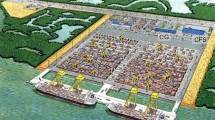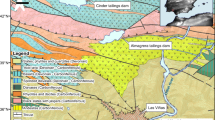Abstract
The Port of Yangon is the largest port in Myanmar and a river port located approximately 40 km upstream from the Yangon estuary. The country’s economic growth has led to the construction of a new container terminal in the Thilawa area, 16 km downstream from the Yangon port. Regardless of the difficult natural conditions in the area, project had to be completed in a short period at the request of the client. In order to shorten the construction period, construction of a jetty using the jacket method and soil improvement combined with the consolidation acceleration method were adopted. After repeated studies, the project was completed in a short period of 915 days. This paper describes the details of these studies.
You have full access to this open access chapter, Download conference paper PDF
Similar content being viewed by others
Keywords
1 Introduction
Myanmar has experienced a rapid increase in logistics due to economic growth following the transfer of civil administration in March 2011.The existing Yangon port was less convenient due to its shallow water depth and the need to wait for high tide to enter the port. Therefore, a new port was to be built in Thilawa area, which is downstream from Yangon Port and has deeper water. Figure 1 shows the location of Yangon city and Thilawa area.
The project contains the construction of a jetty with a length of 400 m and a planned water depth of C.D.L.-10 m. In the land area, 800 m long and 250 m wide (approximately 18 ha) of land was developed filling from the quay to the inland area as shown in Fig. 2. With the aim of constructing the terminal in a short time, the jacket method was adopted for the pier, and soil improvement was adopted in the terminal yard to prevent the ground settlement during terminal operation. Myanmar has a rainy season from June to October, during which a large amount of rain falls, approximately 3000 mm. In addition, the river has a maximum flow velocity of 6knots and tidal levels of H.W.L. +6.24 m and L.W.L. +0.33 m, with a large difference in tide. In order to implement the works under harsh natural conditions, various techniques were used and reported in this paper.
2 Jetty Construction
2.1 Construction Outline
The jetty was constructed adopting jacket method, which is a three-dimensional truss structure called a jacket manufactured onshore and capped on steel pipe piles and then, superstructure was constructed using precast slabs. As the majority of the structure is fabricated on land, this method enables the fabrication of components of uniform quality without being affected by external factors, such as scaffoldings and climate. In addition, the construction period can be shortened because fabrication of precast slabs is carried out simultaneously with pile driving offshore. This method, which requires little underwater work, is useful at this site under conditions of high current velocity and very large tidal differences (Fig. 3).
2.2 Steel Pile Driving
The foundation of the jacket consists of 120 pieces of Ø1300 mm steel pipe piles. As the leg diameter of jacket is Ø1480 mm in relation to the diameter of the piles, the margins are 90 mm on both sides (Fig. 4). Considering the margins and the fabrication accuracy of the jackets, the steel pipe piles required high driving accuracy. Considering harsh conditions in the area, a 400-tonne lifting crane barge equipped with spuds for holding the vessel position and a pile keeper for adjustment of the steel pipe pile position were used and (Fig. 5).
The steel pipe piles were driven with a vibratory hammer for initial driving and a hydraulic hammer for final driving (Table 1). In order to improve the accuracy of driving, time was taken to ensure accuracy in the initial driving.
The results of the pile driving are shown in Fig. 6. The average driving accuracy was 3.8 mm (standard deviation 18.1 mm) on the landward side and 0.04 mm (standard deviation 18.0 mm) downstream. More than 90% of the piles in both straight and perpendicular to the normal direction fell within ±30 mm of the design position, indicating high accuracy of driving.
2.3 Jacket Installation
The size of one jacket is 20 m in the direction normal to the pier and 40 m perpendicular to the pier, weighing 245 t/unit, for a total of 20 jackets (Fig. 7). The jackets were assembled in a temporary yard adjacent to the project site. The fabricated jackets were placed on rollers called tirtanks and transported by winch on a 600 m rail in the temporary yard to the temporary quay. The transported jackets were lifted by a 500t lifting crane barge. To hold the barge in the river, it was transferred by six anchors instead of boats (Fig. 8).
2.4 Installation Schedule
Jacket installation is affected by river conditions. As the draft of the barge is 2.5 m, the tide level must be at least C.D.L. +4.5 m at the time of jacket lifting. In addition, the top elevation of the steel pipe pile is C.D.L. +6.5 m and the pile head needs to be exposed from the water surface during jacket installation, so work must be carried out at a tide level of C.D.L. +5.5 m or less. Therefore, the jacket is lifted at high tide, and by the time the crane barge is moved to install the jacket, subsequently, the tide moves to low tide and the pile heads are protruding. Therefore, a construction plan was elaborated so that a series of operations could be completed in one day from the start of the jacket lifting, based on tide level observations. A cycle of the jacket transportation and installation is shown in Fig. 9. One jacket was successfully installed in a day following this cycle.
3 Soil Improvement
3.1 Overview
The plan view of reclamation and soil improvement works are shown in Fig. 10. The soft clay layer with a thickness of 20 m to 25 m is widely distributed on the site(see Fig. 11), and the terminal will be constructed by reclaiming sand dredged from the Yangon River on top of this layer. Ground improvement was carried out to reduce the residual settlement of the terminal yard due to operational loads during the terminal operation. As it takes a long time for the underlying soil to achieve the required consolidation degree using loading fill only, the PVD (Prefabricated Vertical Drain) method was adopted as a consolidation accelerator.
The series of construction procedures of soil improvement consisted of laying geotextiles on the local bedding, then reclaiming sand using the water spreading method to create a 1 m layer-thick sand mat, and driving PVD in a square arrangement of 1.1 m × 1.1 m. Subsequently, the container yard was filled to a height of C.D.L. +11.2 m and the building area to a height of C.D.L. +9.3 m (see Fig. 12). After leaving the soil to reach the required consolidation degree, the surcharge fill was removed and levelled at the finish grade.
3.2 Geotechnical Investigation and Construction Planning
Prior to construction, detailed soil investigations of the yard were carried out at ten locations to confirm soil properties and soil layer classification. Based on these data, the surcharge fill height and target leaving period were determined. The results of consolidation tests with specimens sampled at the borehole locations are shown in Table 2. The soil model set up based on this data is shown in Fig. 13. Settlement analysis was carried out using the finite element analysis program “DACSAR”Footnote 1 for the settlement observation points.
3.3 Measurement Control
In deciding the removal of the surcharge fill after a period of leftover consolidation, final settlement predictions were made using the Asaoka methodFootnote 2. The final settlement prediction results for each observation point using the Asaoka method are shown in Fig. 14. Even though the loading conditions during construction were similar, the amount and trend of settlement differed at each observation point. The required consolidation ratio and expected residual settlement were obtained from the estimated final settlement. From this, it was confirmed that the removal conditions were met.
4 Conclusion
This project had to be completed in a short time under severe natural conditions. The jetty was built using a jacket method, which is a three-dimensional truss structure to be installed on six number of piles, requires high accuracy of piling. Considering harsh conditions in the area, a 400-tonne lifting crane barge equipped with spuds for holding the vessel position and a pile keeper for adjustment of the steel pipe pile position were used. Spending time to attain accuracy of pile positions during initial driving, more than 90% of the piles were placed within ± 30 mm of the design position, indicating high accuracy of driving.
The fabricated jackets were placed on rollers called tirtanks and transported by winch on a 600 m-rail in the temporary yard to the temporary quay. The transported jackets were lifted by a 500t lifting crane barge. To hold the barge in the river, it was transfered by six anchors instead of boats.
Jacket installation is affected by river conditions of the draft of the barge is 2.5 m. Therefore, the jacket is lifted at high tide, and by the time the crane barge is moved to install the jacket, subsequently, the tide moves to low tide and the pile heads are protruding. Therefore, a construction plan was elaborated so that a series of operations could be completed in one day.
As the container terminal was to be built on soft ground, soil improvement using PVD was used to shorten the improvement period. Prior to construction, detailed soil investigations of the yard were carried out at ten locations to confirm soil properties and soil layer classification. Based on these data, the surcharge fill height and target leaving period were determined. Settlement analysis was carried out using the finite element analysis program “DACSAR” for the settlement observation points. The required consolidation ratio and expected residual settlement were obtained from the estimated final settlement using Asaoka method. From this, it was confirmed that the removal conditions were met.
Notes
- 1.
Atushi IIZUKA and Hideki OHTA. (1987), “A determination procedure of input parameters in elasto-viscoplastic finite element analysis”, Soils and Foundations, Vol.27, No. 3, pp. 71–87.
- 2.
Akira ASAOKA. (1978), “Observational procedure of settlement prediction”, Soils and Foundations, Vol. 18, No. 4, pp. 87–101.
Reference
Murakami H, Tsuchida T, Yamada Y, Aoyama T (2015) Consideration of physical and mechanical characteristics of clayey soils in Myanmar. Japan Geotech Soc 10(1):163–172. (in Japanese)
Acknowledgements
We express our appreciation to the people concerned who gave us the opportunity to write this paper.
Author information
Authors and Affiliations
Corresponding author
Editor information
Editors and Affiliations
Rights and permissions
Open Access This chapter is licensed under the terms of the Creative Commons Attribution 4.0 International License (http://creativecommons.org/licenses/by/4.0/), which permits use, sharing, adaptation, distribution and reproduction in any medium or format, as long as you give appropriate credit to the original author(s) and the source, provide a link to the Creative Commons license and indicate if changes were made.
The images or other third party material in this chapter are included in the chapter's Creative Commons license, unless indicated otherwise in a credit line to the material. If material is not included in the chapter's Creative Commons license and your intended use is not permitted by statutory regulation or exceeds the permitted use, you will need to obtain permission directly from the copyright holder.
Copyright information
© 2023 The Author(s)
About this paper
Cite this paper
Kohno, H., Takahashi, M., Niina, D., Tokiwa, S. (2023). Construction of Container Terminal in the Yangon River. In: Li, Y., Hu, Y., Rigo, P., Lefler, F.E., Zhao, G. (eds) Proceedings of PIANC Smart Rivers 2022. PIANC 2022. Lecture Notes in Civil Engineering, vol 264. Springer, Singapore. https://doi.org/10.1007/978-981-19-6138-0_118
Download citation
DOI: https://doi.org/10.1007/978-981-19-6138-0_118
Published:
Publisher Name: Springer, Singapore
Print ISBN: 978-981-19-6137-3
Online ISBN: 978-981-19-6138-0
eBook Packages: EngineeringEngineering (R0)


















